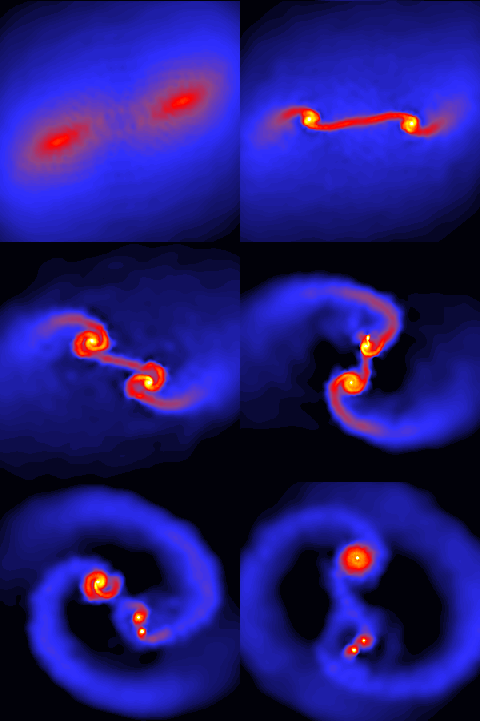
A time sequence showing the collapse and fragmentation of a molecular cloud core to form a bound system of three stars.The initial conditions consist of a spherical cloud of molecular hydrogen gas at a temperature of 10 K, rotating clockwise, with a 50% m=2 density perturbation (i.e. two regions oposite each other in the cloud have a 50% higher density than the mean density of the cloud). As the cloud collapses under its own gravity [Panel 1], these over-dense regions collapse faster than the cloud as a whole, with the result that a binary protostellar system is formed [Panel 2]. The rest of the cloud continues to fall in and, due to the angular momentum of the gas, it forms discs of gas around each of the two protostars [Panel 3]. These discs contain roughly as much mass as the protostars themselves, and are unstable to the growth of non-axisymetric modes. Spiral density waves grow in the discs [Panel 3]. These transfer angular momentum outwards and mass inwards in the discs, stabilising them. In one of the discs, the two sprial arms collide and enough gas is gathered together that it becomes gravitationally unstable itself and collapses to form a third protostar [Panels 4 and 5]. The system finally settles down to form a system of three stars, with a wide binary system whose two components are a close binary system and a lone star surrounded by a large circumstellar disc [Panel 6]. The remaining gas falls in around the system to form a circumbinary disc.The scale of the simulation is such that the side of one panel is 2600 AU long (1 AU is the distance from the Earth to the Sun). Thus the `close' binary has a separation of about 150 AU (3 times the distance between the Sun and Pluto) and the third star orbits 1000 AU from the close binary. The large disc around the third star has a radius of roughly 4 times the distance between the Sun and Pluto, and would be expected to form a planetary system.
(This simulation is from the paper "Modelling accretion in protobinary systems", by Matthew R. Bate, Ian A. Bonnell and Nigel M. Price, 1995, MNRAS, 277, 362-376.) |
